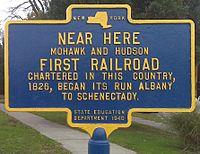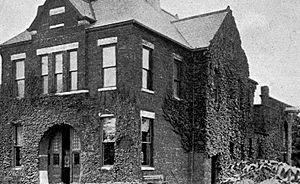Pine Hills, Albany, New York facts for kids
Quick facts for kids
Pine Hills
|
|
|---|---|
|
Neighborhood
|
|
| Etymology: for pine covered hilltops in the area |
|
| Country | United States |
| State | New York |
| County | Albany County |
| City | Albany |
| Settled | Early 19th century |
| Time zone | UTC-5 (Eastern Standard Time) |
| • Summer (DST) | UTC-4 (Eastern Daylight Time) |
| Area code | 518 |
| ZIP code | 12203, 12208 |
Pine Hills is a lively neighborhood in Albany, New York. It stretches from Manning Boulevard in the west to Lake Avenue in the east. To the south, it reaches Woodlawn Avenue, and to the north, Washington Avenue. This area is mostly residential, with many houses for families and students.
Pine Hills is home to several schools, including Albany High School and the College of St. Rose. You'll also find the Alumni Quad of the University at Albany here. While it's mainly a place where people live, Pine Hills also has two main shopping areas. These areas offer stores, restaurants, and other services for the community. A part of Pine Hills, east of Main Avenue, is very popular with college students.
Contents
Discover Pine Hills: A Neighborhood Overview
Pine Hills is known for its beautiful homes. West of Main Avenue, you can see many large houses built in styles like Queen Anne, Folk Victorian, and Colonial Revival. The area around Upper Madison and Western Avenue is a busy commercial hub. It has a movie theater, a grocery store, restaurants, a library, and even a police station.
A Look Back in Time: Pine Hills History
Early Days: Before 1889
Long ago, Pine Hills was part of the Albany Pine Bush. This area had many sand dunes and tall pine trees. These trees were so big, they were used for ship's masts! In 1799, the Great Western Turnpike was built through this land. This important road connected Albany to the western parts of New York. It helped settlers move west and cattlemen bring livestock to sell.
The very first railroad in New York State started here in 1831. It was the Mohawk and Hudson Railroad. This railroad ran from a spot called "the Point" in Pine Hills to Schenectady. It was the first successful passenger steam locomotive in the United States. This train helped people travel faster than the Erie Canal could.
In the mid-1800s, a Catholic Bishop opened St. Vincent's Home for Boys. This home cared for many children who needed help. Later, in 1864, a special law was passed. It stopped the city from extending Madison Avenue further west than Allen Street. That's why Allen Street is still the end of Madison Avenue today.
Building Parks and Roads
In 1869, the New York Legislature decided to create a large public park. This park would be near Pine Hills. It was called Washington Park. A special group was formed to plan and manage the park. This group also built new roads, or "boulevards," around the city. Some of these roads helped Pine Hills grow.
For example, Western Avenue was paved with granite blocks in 1876-1877. Then, in 1878, Northern Boulevard was built. This road is now called Manning Boulevard. It was named after Daniel Manning, who helped with Washington Park. These new roads made it easier to travel to and from Pine Hills.
Growth and Community Spirit
By 1875, horsecar lines reached the edge of Pine Hills. These were like early streetcars pulled by horses. By 1890, electric streetcars replaced the horses, making travel even faster. Small communities like Brady Row and Paigeville grew up near Ontario Street. These areas had wooden houses for workers.
The area between Partridge Street and Main Street, and Madison Avenue and Western Avenue, was once a farm called "Twickenham." After the owner passed away, the land was sold in smaller pieces. By 1889, beautiful Queen Anne style homes were built along Madison Avenue.
Developing Pine Hills: 1869–1980
In 1869, two lawyers, Gaylord Logan and Lewis Pratt, bought a large area of land. They named it Pine Hills because of the many pine trees on the hilltops. They created the Albany Land Improvement Company. In 1881, they started selling lots for homes. They also built tree-lined streets, sidewalks, and put in water, sewer, and gas pipes.
The first homes were built by companies like Sano-Rubin Construction and West End Building Company. The property deeds had rules that said the land could not be used for businesses or selling alcohol. This helped keep Pine Hills a quiet, residential area. Even though the original plan wasn't a financial success for Logan and Pratt, Pine Hills quickly became a popular "semi-suburb."
As the area grew, more services were added. St. Vincent's Church was built in 1887, and St Andrew's Episcopal Church in 1897. In 1891, Fire Engine #10 of the Albany Fire Department opened at "the Point." Public School #4 (PS 4) was built nearby.
In the early 1900s, groups like the Pine Hills Neighborhood Association were formed. They wanted to keep Pine Hills a residential area with a strong community spirit. They even stopped plans for a school for the deaf and a hospital. However, some businesses, like the Pine Hills Pharmacy, were allowed. In 1929, the Madison Theater opened, becoming a popular spot for movies.
Schools and Growth
Many schools opened in Pine Hills during this time. The Vincentian Institute, a Catholic high school, opened in 1921. In 1920, the College of Saint Rose, another Catholic institution, opened on Madison Avenue. In 1923, the St. Vincent's Home for Boys was renamed the La Salle School.
In the late 1920s, a builder named Dan Winchester created a unique subdivision called Winchester Gables. These houses were built in a Spanish style, with stucco walls and red tile roofs. They even had small towers!
The Albany Police Department opened its 6th Precinct in Pine Hills in 1927. Public School #16 (PS 16) was expanded in 1930 because more families were moving to the area. The University at Albany, SUNY also built dormitories in Pine Hills for its students, starting in the 1930s.
Modern Times: After 1980
The late 1980s and early 1990s brought some changes to Pine Hills. In 1988, Fire Engine #10 moved to a new building outside the neighborhood. The old fire station was later turned into a community playhouse. The Pine Hills branch of the Albany Public Library also moved into a renovated former telephone building. This building, at 517 Western Avenue, is an Art Deco style building from 1930.
The Madison Theater was updated in 1995, becoming a five-screen movie theater. In 1989, several streets in Pine Hills became one-way to help traffic flow better.
In 2003, the Madison Theater closed for a short time. There were plans to replace it with a large pharmacy, but the neighborhood opposed it. In 2005, the theater was bought and reopened as a movie theater again.
In 2005, PS 16 was taken down to make way for a larger, modern school. The new Pine Hills Elementary School opened in 2007. The Albany Public Library's Pine Hills Branch was also renovated in 2008.
Location of Pine Hills
 |
Melrose | Upper Washington Avenue | Beverwyck |  |
| Buckingham Lake (neighborhood) | Washington Park | |||
| New Scotland/Woodlawn | Park South |
Fun and Games: Recreation in Pine Hills
Pine Hills has several great parks and recreation centers for everyone to enjoy.
- Ridgefield Park on Partridge Street has fields for baseball, softball, and soccer. It also has tennis courts, a community garden, and a spray pool for hot days.
- Woodlawn Park, at Woodlawn Avenue and Partridge Street, offers ball fields, basketball courts, and a playground.
- The Madison Avenue Playground, at Ontario Street and Madison Avenue, is a smaller park with basketball courts and a playground.
- The St Vincent's Community Center has game rooms with ping pong, pool tables, and board games. It also has a gym for basketball, volleyball, and whiffleball leagues for kids.
Getting Around: Transportation in Pine Hills
Pine Hills is located where two major Albany roads meet: Madison Avenue and Western Avenue. Madison Avenue is part of US Route 20 (US 20). These are important roads for traveling east and west. Washington Avenue forms the northern edge of the neighborhood.
Several major north-south streets run through Pine Hills, including Lake, Quail, Partridge, Main, and Manning avenues. The Capital District Transportation Authority (CDTA) runs many bus lines through the area. This makes it easy to get around Pine Hills and to other parts of the city.
Learning in Pine Hills: Education
Children living in Pine Hills attend schools within the City School District of Albany.
- Pine Hills Elementary School teaches students from kindergarten through 5th grade. It's located at 51 North Allen Street, right in the heart of the neighborhood.
- After elementary school, students go to Stephen and Harriet Myers Middle School for grades 6-8.
- Finally, students attend Albany High, which is at the edge of Pine Hills and easy to walk to for many students.
Private and Higher Education
- The La Salle School is a private Catholic school. It provides education for students in grades 6 through 12, especially for young people who may be facing challenges.
- The College of Saint Rose is a private college that started as a Catholic school for women. Today, it welcomes both male and female students and offers many different subjects. The college campus is spread throughout the Pine Hills community, using both new buildings and converted homes.
- While the University at Albany, SUNY doesn't have its main campus in Pine Hills, it does have dorms here. These dorms, called Alumni Quad, provide housing for many college students.




